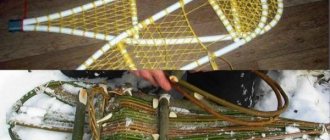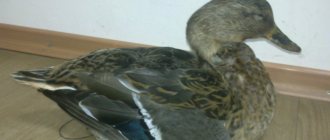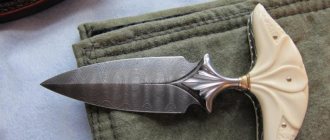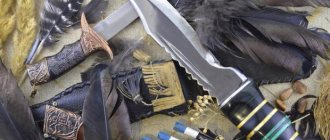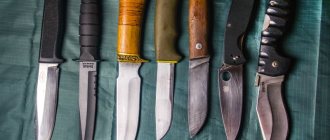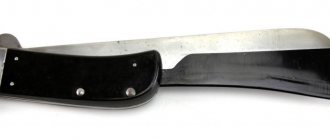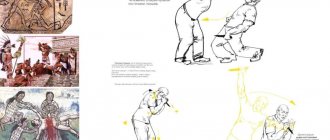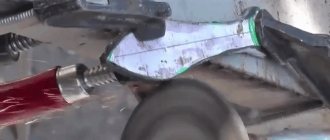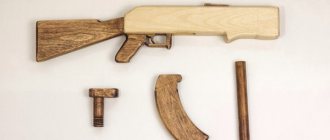Kuki is a Nepalese knife that has a history of at least 1500 years (there is no reliable information). According to the legislation of the Russian Federation, it does not apply to edged weapons, because sharpening is carried out at an angle of 70 degrees, and the thickness of the butt is only 10 mm on average. The center of gravity is at the tip of the blade, sharpening is performed only on the concave side.
The cost of kukri ranges from 4,800 to 12,600 rubles and depends on the country of origin and the quality of the steel used.
Main characteristics of kukri
Kukri is a Nepalese fighting knife, more often found among the highlanders of the Gurhi tribe. It is a massive curved blade; it is used by police and military personnel of the state. Until 2006, the coat of arms of Nepal featured an image of two crossed kukris.
| Characteristic | Brief Explanation |
| Blade shape | Curved inwards, looks like a sickle |
| Blade sharpening | Done only on the concave side |
| Handle material | Wood or buffalo horn |
| Center of gravity location | At the tip of the blade |
| Weapon weight | 600 g |
| Length | 200-400 mm |
| Butt thickness | 8-12 mm |
Features of the Kurki knife from Nepal:
- zone hardening of the blade - hard on the blade, softer on the spine;
- the blade has valleys (lobes) - longitudinal grooves on both sides of the butt;
- the blade has a triangular cross-section;
- the metal is sharpened at different angles, which makes it possible to use it not only for combat purposes, but also for housework;
- There is a recess near the handle, it reduces the stress of the steel and prevents the formation of chips on the blade;
- the handle has a pommel made of steel or brass; it is used for chopping nuts, hammering nails and performing any blows.
We recommend reading the article about file knives. From it you will learn about the features of knives, their pros and cons, steel for production, how to make it yourself, harden and temper it at home. And here is more information about sharpening options at home.
History of kukri
The history of the kukri knife began about 1500 years ago, so this weapon is considered the most ancient in the world - there are accurate records about it from the 15th century. It is believed that the kukri is a modification of the sword from Ancient Egypt and Greece. Representatives of the Gurkha tribe believe that their knife is alive and categorically do not accept its improper use (for example, if it is actively twirled with a brush, used as a fencing weapon or for stabbing).
Historically, boys are taught to own kukri from a young age. The basic rule: a knife that has already been removed from its sheath must definitely “taste” the taste of blood before it goes back. Kukri is not taken out without a reason, and if this happens, the man must cut his own finger and “extract” at least a drop of blood from it.
It is interesting that Gurkhas never use their knives for fighting unnecessarily, but if necessary, he can deliver a fatal blow quickly, literally with lightning speed.
The Gurkha tribe are born warriors
What is it needed for
Residents of Nepal use a kukri knife not only for fighting, it is also needed for:
- sugar cane cutting;
- preparing vine stems for the construction of huts;
- clearing paths in the impenetrable jungle.
But kukri is absolutely not suitable for working with tree branches, even if they are thin. It is also impossible to use Nepalese weapons for cleaning or cutting meat, fish, vegetables, and baked goods.

Is it a cold weapon or not?
A kukri knife is not a bladed weapon, because the deflection parameters of the butt are more than 15 mm, and the sharpening angle of the blade tip is more than 70 degrees . According to the legislation of the Russian Federation, cutting tools of this type belong to the household category; they cannot be pierced.
In this case, the length of the blade or the entire weapon, the presence of a guard and fullers are completely unimportant - the sharpening and bending angle of the butt are taken into account. If the kukri is not altered or made strictly according to standards, then there is no need to worry about legislation and prohibitions on storage/carrying.
Watch the video review of the Gurkha knife-sword:
Product modifications
The usual length of the blade ranges from 200 to 400 mm, the thickness of the butt is from 8 to 12 mm. The knife is sharpened with a variable angle, thanks to which its cutting part can be used for cutting, planing, dissecting, and chopping.
In Nepal you can see various modifications of the knife, which differ in the shape of the blade and handle, weight and size. This is explained by the fact that kukris have different purposes. The following types of products are manufactured:
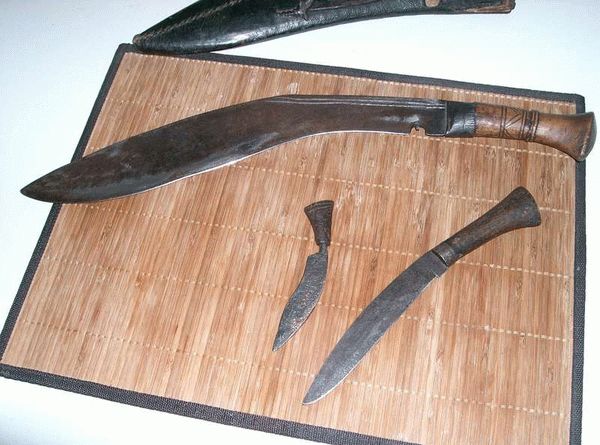
Local blacksmith schools make kukri of various shapes and weights. Carbon steel, obtained from railway equipment and decommissioned rails, was previously used as a material for making blades. Nowadays, blacksmiths use springs from buses and trucks. German products are in particular demand, less often - Japanese ones. Making kukri has the following nuances:
- Weapons are produced using ancient technology using hand forging. Hammers are often involved in its production.
- Zone hardening of the blade allows you to increase its strength and give it excellent cutting characteristics. The body of the blade is hardened to HRC 35-48, near the cutting edge - to HRC 56-58.
- The blade has the smallest sharpening at the handle, and the greatest sharpening in the middle part.
- There are two types of dols - chirra (wide and shallow) and khol (narrower and deeper). The first passes near the cutting edge, the second - near the butt. In large-sized antique products, the hall notch made it possible to reduce the weight of the blade.
- The handle of a traditional kukri used to be made of horn or precious wood. Usually it was mounted, less often - plate-shaped, fastened with rivets. Many surviving ancient specimens are equipped with items made of ivory or rhinoceros horn. Currently, brass, expensive hard wood, and aluminum alloys are used for this purpose. On inexpensive models, the handles are made of rubber-like plastic with an anti-slip treatment.
- The scabbard of an ancient combat knife was made of wood, covered with leather. They contained two more knives of a similar shape, but smaller in size. One small kukri was used for household work, the other was very hard and had a rough surface. It was used to light a fire and straighten the blade of a combat knife. Modern army kukris do not have additional knives.
This is interesting: Adjusting the optical sight
Elements of a kukri knife
The kukri knife has individual elements that are closely related to the legends and history of the Nepalese:
- The dol on the blade is considered to belong to God; Nepalese call it the sword of Shiva. It is he who endows the weapon with divine power and allows you to destroy all enemies.
- The rings on the handle symbolize the levels of the universe. Tourists believe that they make the position of the weapon in the hand as comfortable as possible, but in fact they rub the skin until it bleeds.
- The variable-angle blade symbolizes the Sun and Moon, which are considered traditional symbols of Nepal.
- The notch on the blade as close as possible to the handle is called “cho”. Its true purpose is unknown, but it is assumed that it was used to protect the blade from cracks and chips in the metal. This notch can have different shapes, often called the trident (tooth) of Shiva or the symbol of the goddess Kali.
- The pommel on the handle is perceived by Nepalese as the all-seeing eye of God.
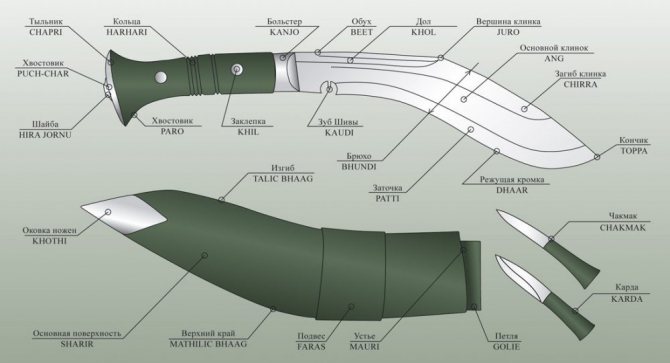
Why is Shiva's tooth on a knife?
The Shiva tooth on the kukri knife is needed to honor the historical use of the weapon: Nepalese men pierce their finger with it to anoint the blade before sheathing it. The second purpose is to inhibit the formation of chips at the base of the blade, which is often noted after chopping blows.
Is it foldable?
Kukri folding knives are sold in souvenir shops in Nepal; they are not used as military weapons and are modern modifications of ancient weapons. It can be used for hiking and fishing. The blade is made of high carbon steel, is considered universal and can be used to perform even rough work, for example, cutting nets and ropes/cables.
The total length of the folding kukri is 250 mm, the same parameter for the blade is 110 mm.
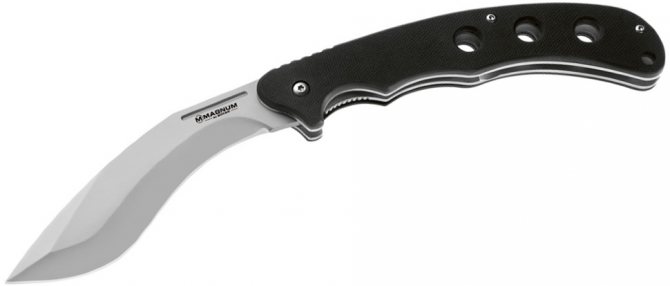
Possession technique
The technique of wielding kukri is individual; the Nepalese did not specifically develop it and used their combat knives to attack the enemy. In this case, the knife is in the hand, which is pulled back/retracted and slightly raised upward. The palm is placed on the handle with an overhand grip, the hands are positioned as close as possible to the blade.
Kukri deliver chopping blows; if you turn the knife with the handle forward, you can also deliver blows similar to hammering nails. There is no point in rotating the weapon with a brush or trying to make a cutting movement - nothing will work, and the Nepalese will be completely offended by such an attitude towards the most ancient knife in the world.
Watch the video to practice the technique of stabbing with a kukri knife:
History of kukri
The Nepalese knife is one of the most ancient types of bladed weapons that has survived to this day in its original form. Nepalese believe that they had these knives at the dawn of centuries, and the first examples of kukri were taken from the brave Macedonians by ancient Nepalese warriors. Of course, this is nothing more than a beautiful legend, since the Greek phalanx was invulnerable to the wild Nepalese tribe, even if you believe that they once met.
In any case, drawings of weapons that look like kukri can be made from models of traditional weapons of the following peoples:
- Sword of the ancient Greeks;
- Turkish scimitar.
A blow with a curved massive blade in the shape of a “falcon wing” is much more powerful than the same blow with a straight blade. In Nepalese museums, the oldest examples of traditional knives date back to only the 14th century. Although there are references in written sources starting from the 7th century.
The dimensions of the ancient kukri knife do not exceed modern analogues. The Gurkhas, who previously took part in military skirmishes with England, clearly demonstrated the power of this blade - they cut off heads with one blow.
Varieties of kukri-machete
The Kukri is often called the Nepalese machete because the weapon comes in several types and most often has the shape of a large chopping instrument. The most famous types are:
- Hanshi - refers exclusively to utility knives, used as a sickle;
- Catrimoras - richly decorated weapons, used as souvenirs;
- Bhojpuri/Ang Khola - intended for farming, has an average blade thickness of 10 mm;
- Janavar katne - the blade is thin and long, very similar to a traditional sword;
- Sirupati - produced only in the south of Nepal, considered the narrowest knife;
- Badhum - characterized by a thick and short blade with a large width;
- Bunspati is a true combat weapon with a narrow blade.
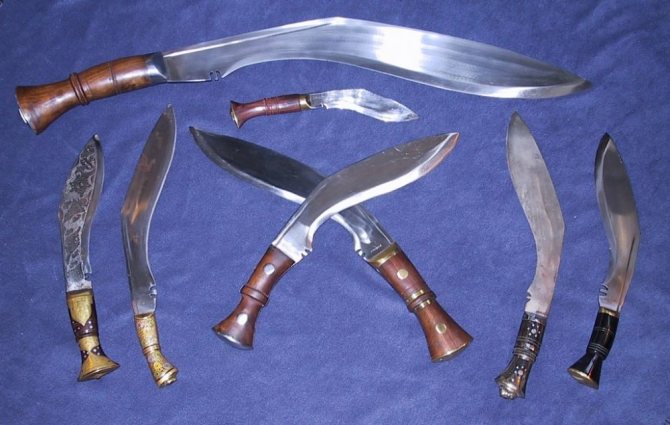
Varieties of kukri
Using kukri in combat
Although at the beginning of the 19th century edged weapons in Europe had long since lost their leading position, when the British army tried to conquer Nepal, it had to face the traditional kukri knives of the local population. Due to the fact that Nepal was a backward country, most Gurkhas had only these weapons.
This is interesting: How a collimator sight works: what it is and how it works
The contempt of the British soldiers for the “savages with crooked pieces of iron” quickly gave way, first to respect, and then to horror. Even Gurkha soldiers armed with outdated rifles, having used up all their ammunition, grabbed kukris and rushed into battle. It was at that time that legends about this ancient knife began to spread among the European population.
Local residents were trained in traditional knife fighting from an early age, and the kukri was the local equivalent of a machete, which every peasant had. In addition, there is information about the existence of an entire combat school called “kukri”. It is unknown whether this is true or a publicity stunt, but people trained to wield these weapons from childhood can be very dangerous indeed to their enemies.
Gurkhas are not quite typical Indians, who are quite peaceful people who try to avoid violence. A Gurkha raised in the traditional style will avoid combat conflict, he may even run away, but if he takes out a knife, he will definitely strike. Having killed the enemy, he will not feel remorse, because he was raised that way.
Advantages and disadvantages of Nepalese kukri
Nepalese kukri has the following advantages:
- heavy blade;
- delivers perfect slashes;
- can also be used for some household work;
- Suitable for striking with a pommel.
But this type of knife also has its disadvantages:
- centering located closer to the tip - the knife is uncomfortable to hold in the hand;
- the presence of notches/rings on the handle – the palm rubs until it bleeds, subsequently the skin becomes rough;
- it is impossible to apply cutting blows;
- You can’t use kukri in the kitchen - you won’t even be able to cut meat, fish, or peel vegetables.
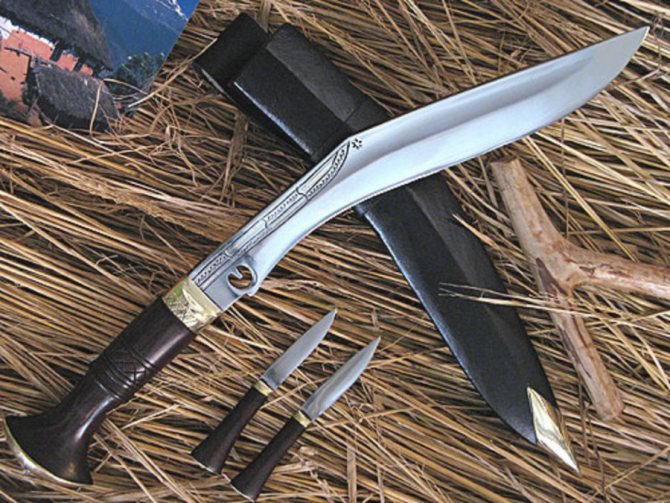
Kukri knife: drawings with dimensions, materials
To make a kukri knife yourself according to drawings, you will need the following materials for work:
- high-carbon steel - springs, wood saw blades;
- furnace for heating metal;
- hammer weighing at least 3 kg;
- metal cutter;
- a hammer weighing 1.5 kg for finishing the blade;
- metal rod;
- file with a fine abrasive surface;
- a strip of leather for polishing the blade;
- wood glue.
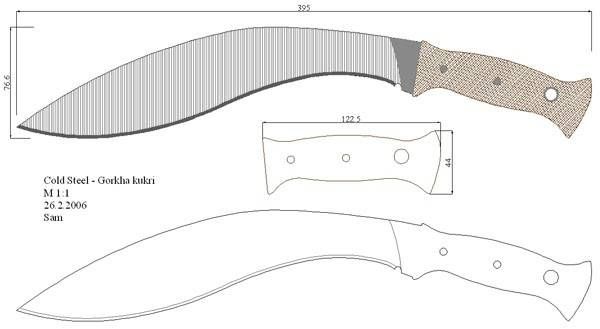
Kukri drawing with dimensions
How to sketch
The sketch is made on thick cardboard, the drawing is simply redrawn on a sheet of paper with strict adherence to all parameters. Then a pattern is cut out along the contours. It is imperative to make 0.5-1 cm overlaps along the contour - this will make it possible to process the edges of the weapon with a file.

DIY making
Making a kukri knife with your own hands is carried out according to the following algorithm:
- A pattern is applied to a piece of steel, then the contours with laps are drawn with an awl with an ebonite tip (or any other tool).
- A blade blank is cut out using a grinder.
- The metal workpiece is heated red-hot in a furnace or over an open fire.
- Forging is performed, during which both the blade and the handle are formed. This stage is performed with a three-kilogram hammer. Time - 30 minutes, you need to work together, constantly hitting the metal.
- As soon as the metal changes color from red to dark, it is heated again in the furnace. Then they continue to beat the steel with a 1.5 kg hammer. They work together, constantly changing surfaces and at the same time forming the bend of the blade.
- A groove is made on the “belly” of the blade - a metal rod is pressed against the edge of the blade and beaten with a slightly light hammer. Then the steel is heated, the rod cuts off part of the metal - you get an even groove (full).
- Zone hardening is carried out - a thin stream of cold water is poured onto the blade. Only that part of the blade that is located closer to the tip is processed.
- Sharpening is done with a file. 2 sides of the blade are processed at once. Final sanding requires the use of fine sandpaper.
- Polishing work is carried out with a strip of genuine leather, ideally buffalo.
Watch the video on how to make kukri with your own hands from a spring:
While working on a knife, you need to periodically pour cold water over the metal workpiece, then heat it until red-hot - this is how the steel is hardened.
The kukri handle is made from a wooden block, with a hole drilled inside for the shank. The specified part of the knife is attached to the handle using wood glue. Next, the selected shape of the handle is given using grinding tools and regular sandpaper.
History of the knife
As an independent type of agricultural tool, the machete first began to be used when harvesting sugar cane. With its help, the jungle was cleared for new plantations. The heavy, wide blade easily cut through thickets of bushes and helped pave the road. The length of the blade from 35 to 60 cm and a thickness of 3-4 mm turned it into a formidable weapon, which was subsequently used by rebels and armed forces of different countries.
Such weapons were used not only in South American countries. In Nepal, Gurkha warriors have used the kukri, an analogue of a machete knife, since the 15th century. Depending on its purpose, it has several varieties:
- Badhum is a combat knife with a very thick blade - 0.8 cm.
- Hanshi is an agricultural tool that replaces the Gurkha sickle.
- British army service - military weapons used in service
The modern machete knife has significantly expanded its functionality in comparison with the prototype. The blades of some models additionally have a saw. Knives made for tourism have hollow handles in which you can store survival kit: fishing line, fishing hooks, flint. For arming US special forces, a folding machete knife is produced for safe landing.
Kukri sheath
Kukri sheaths are made of genuine leather. It is pre-soaked in water, then it is fixed on the weapon strictly according to the shape of the blade. Do not remove the material until it is completely dry under natural conditions.
The final stage is to fasten the two parts of the sheath with rivets, the excess is cut off with a sharp knife. You can make a pattern on the surface of the sheath or make decorative stitches around the perimeter using thick nylon threads or thinly sliced leather.
How to choose kukri knives
When buying a kukri knife, you need to make a choice taking into account the following recommendations from experts:
- the thickness of the butt should be 5 mm and above;
- the handle is made of wood and does not have rings (the palm will not be rubbed);
- there must be a notch on the blade in front of the handle (“Shiva’s tooth”);
- the total length of the knife is within 200-300 mm;
- steel – high-carbon (according to the manufacturer’s request).
We recommend reading the article about the best switchblades. From it you will learn about the main characteristics of switchblades, their types, and handmade switchblades. And here is more information on how to make a knife yourself.
Kukri is an original, historical knife that is rarely used for household needs, but is of interest to collectors and lovers of hiking and fishing. If you buy a really high-quality weapon, it will serve “faithfully” for many years.
Why is kukri needed in peacetime?
For the people of Nepal, the traditional kukri knife is not only a weapon. For the peasants and mountaineers of Nepal, it replaces the ax. Since many locals live in light huts, the kukri is used as a construction tool to chop vines and bamboo stalks. In addition, this weapon is part of the equipment of local hunters who clear paths in the jungle for them.
However, you should not think that the same knife is used for fighting and for cutting cane. Real military weapons will never be used as an agricultural tool. For this, there are simpler models that do not carry any sacred meaning.
Currently, kukris are sold as souvenirs. These are the knives that tourists bring from Nepal. As a rule, these are low-quality products that can only be hung on the wall. Numerous tests have proven that most blades are too soft, and the handles fall apart the first time they work on wood. Although kukris are made of better quality for the local army and police.
If a person is faced with the task of buying not just a souvenir, but a real working tool, then he needs to look for it from local blacksmiths. In this case, the shank should be through, or better yet, an all-metal handle, with wooden or horn linings. If identity is not the main parameter, then it is better to order a Nepalese knife from domestic blacksmiths who use high-quality steel when forging.
Currently, souvenir knives are produced in the following countries:
Pakistani knives made from Damascus look the most beautiful. Do not delude yourself about its quality; as a rule, it is inferior even to good carbon steel.
